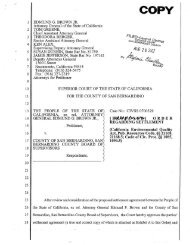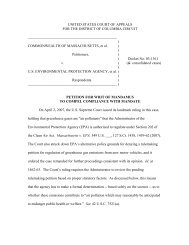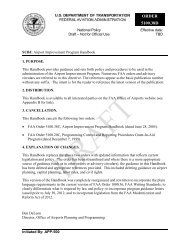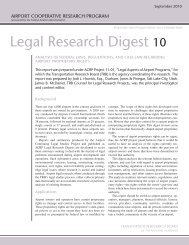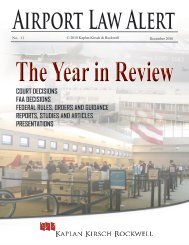Aspen-Pitkin County Airport Greenhouse Gas Emissions Inventory ...
Aspen-Pitkin County Airport Greenhouse Gas Emissions Inventory ...
Aspen-Pitkin County Airport Greenhouse Gas Emissions Inventory ...
Create successful ePaper yourself
Turn your PDF publications into a flip-book with our unique Google optimized e-Paper software.
oil, sludge waste, waste alcohol, municipal solid waste, landfill gases, other waste, and ethanol blendedinto motor gasoline.BIOMASS: Total dry weight of all living organisms that can be supported at each tropic level in a foodchain. Also, materials that are biological in origin, including organic material (both living and dead) fromabove and below ground, for example, trees, crops, grasses, tree litter, roots, and animals and animalwaste.BIOMASS ENERGY: Energy produced by combusting biomass materials such as wood. The carbondioxide emitted from burning biomass will not increase total atmospheric carbon dioxide if thisconsumption is done on a sustainable basis (i.e., if in a given period of time, re-growth of biomass takesup as much carbon dioxide as is released from biomass combustion). Biomass energy is often suggestedas a replacement for fossil fuel combustion.BRITISH THERMAL UNIT (Btu): The quantity of heat required to raise the temperature of one poundof water one degree of Fahrenheit at or near 39.2 degrees Fahrenheit.BUNKER FUEL: Fuel supplied to ships and aircraft for international transportation, irrespective of theflag of the carrier, consisting primarily of residual and distillate fuel oil for ships and jet fuel for aircraft.CARBON BLACK: An amorphous form of carbon, produced commercially by thermal or oxidativedecomposition of hydrocarbons and used principally in rubber goods, pigments, and printer’s ink.CARBON CYCLE: All carbon reservoirs and exchanges of carbon from reservoir to reservoir by variouschemical, physical, geological, and biological processes. Usually thought of as a series of the four mainreservoirs of carbon interconnected by pathways of exchange. The four reservoirs, regions of the Earth inwhich carbon behaves in a systematic manner, are the atmosphere, terrestrial biosphere (usually includesfreshwater systems), oceans, and sediments (includes fossil fuels). Each of these global reservoirs may besubdivided into smaller pools, ranging in size from individual communities or ecosystems to the total ofall living organisms (biota).CARBON DIOXIDE: A colorless, odorless, non-poisonous gas that is a normal part of the ambient air.Carbon dioxide is a product of fossil fuel combustion. Although carbon dioxide does not directly impairhuman health, it is a greenhouse gas that traps terrestrial (i.e., infrared) radiation and contributes to thepotential for global warming.CARBON EQUIVALENT (CE) or Carbon Dioxide Equivalent: A metric measure used to comparethe emissions of the different greenhouse gases based upon their global warming potential (GWP).<strong>Greenhouse</strong> gas emissions in the United States are most commonly expressed as “million metric tons ofcarbon equivalents” (MMTCE). Global warming potentials are used to convert greenhouse gases tocarbon dioxide equivalents (CO 2-eq ).CARBON SEQUESTRATION: The uptake and storage of carbon. Trees and plants, for example,absorb carbon dioxide, release the oxygen and store the carbon. Fossil fuels were at one time biomass andcontinue to store the carbon until burned.CARBON SINKS: Carbon reservoirs and conditions that take-in and store more carbon (i.e., carbonsequestration) than they release. Carbon sinks can serve to partially offset greenhouse gas emissions.Forests and oceans are large carbon sinks.CARBON TETRACHLORIDE (CCl 4 ): A compound consisting of one carbon atom and four chlorineatoms. It is an ozone depleting substance. Carbon tetrachloride was widely used as a raw material in manyindustrial applications, including the production of chlorofluorocarbons, and as a solvent. Solvent use wasended in the United States when it was discovered to be carcinogenic.A-2 4/3/2008



